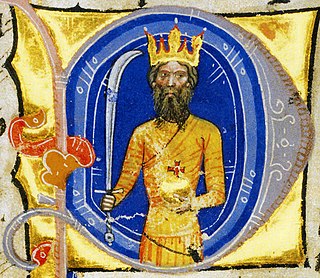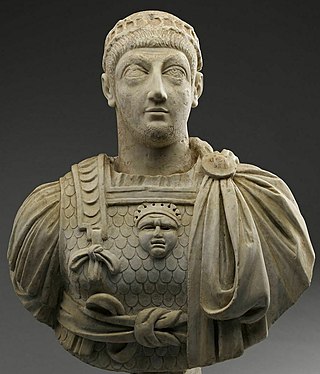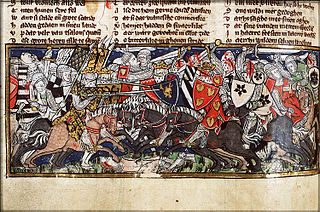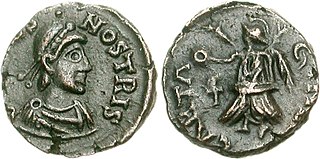Related Research Articles

Attila, frequently called Attila the Hun, was the ruler of the Huns from 434 until his death in March 453. He was also the leader of a tribal empire consisting of Huns, Ostrogoths, Alans, and Bulgars, among others, in Central and Eastern Europe.

The Huns were a nomadic people who lived in Central Asia, the Caucasus, and Eastern Europe between the 4th and 6th century AD. According to European tradition, they were first reported living east of the Volga River, in an area that was part of Scythia at the time; the Huns' arrival to Europe is associated with the migration westward of an Iranian people, the Alans. By 370 AD, the Huns had arrived on the Volga, and by 430, they had established a vast, if short-lived, dominion in Europe, conquering the Goths and many other Germanic peoples living outside of Roman borders and causing many others to flee into Roman territory. The Huns, especially under their King Attila, made frequent and devastating raids into the Eastern Roman Empire. In 451, they invaded the Western Roman province of Gaul, where they fought a combined army of Romans and Visigoths at the Battle of the Catalaunian Fields, and in 452, they invaded Italy. After the death of Attila in 453, the Huns ceased to be a major threat to Rome and lost much of their empire following the Battle of Nedao. Descendants of the Huns, or successors with similar names, are recorded by neighboring populations to the south, east, and west as having occupied parts of Eastern Europe and Central Asia from about the 4th to 6th centuries. Variants of the Hun name are recorded in the Caucasus until the early 8th century.
The 430s decade ran from January 1, 430, to December 31, 439.
The 450s decade ran from January 1, 450, to December 31, 459.
The 440s decade ran from January 1, 440, to December 31, 449.

Valentinian III was Roman emperor in the West from 425 to 455. Made emperor in childhood, his reign over the Roman Empire was one of the longest, but was dominated by powerful generals vying for power amid civil wars and the invasions of Late Antiquity's Migration Period, including the campaigns of Attila the Hun.

Aetius was a Roman general and statesman of the closing period of the Western Roman Empire. He was a military commander and the most influential man in the Empire for two decades (433–454). He managed policy in regard to the attacks of barbarian federates settled throughout the West. Notably, he mustered a large Roman and allied (foederati) army in the Battle of the Catalaunian Plains, ending a devastating invasion of Gaul by Attila in 451, though the Hun and his subjugated allies still managed to invade Italy the following year, an incursion best remembered for the ruthless Sack of Aquileia and the intercession of Pope Leo I.

The Battle of the Catalaunian Plains, also called the Battle of the Campus Mauriacus, Battle of Châlons, Battle of Troyes or the Battle of Maurica, took place on June 20, 451 AD, between a coalition – led by the Roman general Flavius Aetius and by the Visigothic king Theodoric I – against the Huns and their vassals – commanded by their king Attila. It proved one of the last major military operations of the Western Roman Empire, although Germanic foederati composed the majority of the coalition army. Whether the battle was of strategic significance is disputed; historians generally agree that the Siege of Orleans was the decisive moment in the campaign and stopped the Huns' attempt to advance any further into Roman territory or establish vassals in Roman Gaul. However, the Huns successfully looted and pillaged much of Gaul and crippled the military capacity of the Romans and Visigoths. Attila died only two years later, in 453; after the Battle of Nedao in 454, the coalition of the Huns and the incorporated Germanic vassals gradually disintegrated.

Bleda was a Hunnic ruler, the brother of Attila the Hun.

Bonifatius was a Roman general and governor of the diocese of Africa. He campaigned against the Visigoths in Gaul and the Vandals in North Africa. An ally of Galla Placidia, mother and advisor of Valentinian III, Bonifacius engaged in Roman civil wars on her behalf against the generals Felix in 427-429 and Aetius in 432. Although he defeated the latter at the Battle of Rimini, Bonifacius suffered a fatal wound and was succeeded by his son-in-law Sebastianus as patricius of the Western Roman Empire.

The Battle of Rimini was fought in 432 between the two strong men of the Western Roman Empire, the very recently deposed Magister Utriusque Militiae Flavius Aetius and the newly appointed Magister Utriusque Militiae Bonifatius.

Attila is a 2001 American television miniseries set during the waning days of the Western Roman Empire, in particular during the invasions of the Huns in Europe.

Attila is a 1954 Italian-French co-production, directed by Pietro Francisci and produced by Dino De Laurentiis and Carlo Ponti for Lux Film. Based on the life of Attila the Hun, it stars Anthony Quinn as Attila and Sophia Loren as Honoria, with French leading man, Henri Vidal, as the Hun's antagonist, Flavius Aetius. Irene Papas, in the second of three contract pictures for Lux Film, plays one of Attila's wives, Grune. Ettore Manni, Christian Marquand, and Claude Laydu are among the supporting cast of mostly French and Italian actors. American Scott Marlowe (1932–2001) made his screen debut in the film. Along with The Pride and the Passion and Houseboat, it was one of Loren's biggest box-office successes during the 1950s.

The siege of Hippo Regius was a siege from June 430 to August 431, carried out by the Vandals under their king Genseric against Roman defenders under Boniface, Count of Africa.
The history of the Huns spans the time from before their first secure recorded appearance in Europe around 370 AD to after the disintegration of their empire around 469. The Huns likely entered Western Asia shortly before 370 from Central Asia: they first conquered the Goths and the Alans, pushing a number of tribes to seek refuge within the Roman Empire. In the following years, the Huns conquered most of the Germanic and Scythian barbarian tribes outside of the borders of the Roman Empire. They also launched invasions of both the Asian provinces of Rome and the Sasanian Empire in 375. Under Uldin, the first Hunnic ruler named in contemporary sources, the Huns launched a first unsuccessful large-scale raid into the Eastern Roman Empire in Europe in 408. From the 420s, the Huns were led by the brothers Octar and Ruga, who both cooperated with and threatened the Romans. Upon Ruga's death in 435, his nephews Bleda and Attila became the new rulers of the Huns, and launched a successful raid into the Eastern Roman Empire before making peace and securing an annual tribute and trading raids under the Treaty of Margus. Attila appears to have killed his brother and became sole ruler of the Huns in 445. He would go on to rule for the next eight years, launching a devastating raid on the Eastern Roman Empire in 447, followed by an invasion of Gaul in 451. Attila is traditionally held to have been defeated in Gaul at the Battle of the Catalaunian Fields, however some scholars hold the battle to have been a draw or Hunnic victory. The following year, the Huns invaded Italy and encountered no serious resistance before turning back.

The Vandal conquest of Roman Africa, also known as the Vandal conquest of North Africa was the conquest of Mauretania Tingitana, Mauretania Caesariensis, and Africa Proconsolaris by the migrating Vandals and Alans. The conflict lasted 13 years with a period of four years of peace, and led to the establishment of the Vandal Kingdom in 435.
Chelchal was a Hun commander serving as lieutenant general under the Byzantine Empire.
Zolban or Zolbon was a Hun general fighting for the Byzantine Empire. He fought alongside fellow Hun commander Sigizan against the Isaurians in 493 AD.
Thraustila was a Hun or a Goth bodyguard of Roman general Aetius, who participated in the assassination of Emperor Valentinian III, ordered by Petronius Maximus. He probably served Aetius as a bucellarius.
Optila was a either a Hun or a Goth bodyguard working for general Aetius and later for Roman Emperor Valentinian III. He is best known for being the assassin of Valentinian III, himself the assassin of Aetius.
References
- 1 2 Schultheis, Evan Michael (2019). The Battle of the Catalaunian Fields AD 451 Flavius Aetius, Attila the Hun and the Transformation of Gaul. Pen & Sword Books. ISBN 9781526745668 . Retrieved 27 October 2022.
- 1 2 Hughes, Ian (2012). Aetius Attila's Nemesis. Pen & Sword Books. ISBN 9781783461349 . Retrieved 27 October 2022.
- ↑ Maenchen-Helfen, Otto J. "The World of the Huns. Chapter IX. Language". www.kroraina.com. Retrieved 27 October 2022.
- ↑ Syvänne, Ilkka (2020). Military History of Late Rome 425–457. Pen & Sword Books. p. 15. ISBN 9781473872172 . Retrieved 27 October 2022.